Engaging learners online can be a challenging task. To create a warm and welcoming class community, icebreakers are essential tools. You can start each virtual session with one, or add in a spontaneous icebreaker when you feel a dip in the energy of the class.
In order to create an active learning environment where members feel comfortable participating in questions and discussions, it’s important to set the right tone from the beginning. That’s why we’ve put together a list of the best icebreaker activities specifically designed for online engagement with students and coworkers.
Let’s start by explaining what a virtual icebreaker is and why having one ready for your next meeting can be so beneficial. Breaking the ice has never been easier!
What Are Virtual Icebreakers?
Virtual icebreakers are engaging activities designed to lighten the mood at the beginning of a meeting or a class. They serve as excellent conversation starters, energizing participants, sparking lively discussions, and encouraging everyone to be more active throughout the session.
In online and hybrid meetings, virtual icebreakers add a personal touch to video calls, helping colleagues or students connect and enjoy some social interaction. Whether you opt for quick questions or more elaborate games, there’s an icebreaker to suit every preference!
Best Icebreakers for Engaged Learning Online
1. This or That
How It Works: Begin your session with a series of poll questions presenting two choices, either words or images. These can range from fun and light-hearted (like "Cats or Dogs?") to course-related topics. Arrange your learners in small groups, and ask them to work together to choose options and discuss their choices.
Why It's Effective: This activity not only lightens the mood but also sparks conversation and debate. Sharing poll results and encouraging learners to explain their choices to the whole class can lead to interesting discussions and insights into their personalities.
Additional Pair Ideas for "This or That"
Engage your learners with these intriguing pair choices:
- Lifestyle Choices: Board games or card games? Physical book or ebook? Country or city living?
- Food Preferences: Pancakes or waffles? Tacos or wings? Coffee or tea?
- Technology and Hobbies: New phone or new laptop? Television series or movies? Morning or night person?
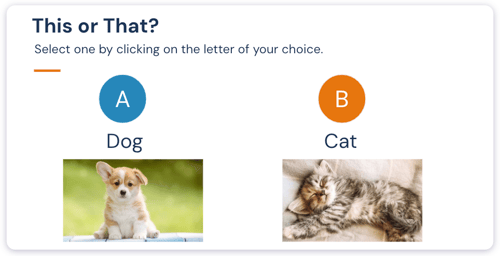
2. Two Truths and a Lie
How It Works: Each learner shares three statements about themselves: two truths and one lie. The statements are shared with the rest of the class, who try to guess which one is the lie. To add a layer of challenge, encourage your students to make their truths as unbelievable as possible!
Why It's Effective: This classic game serves multiple purposes - is great for laughter and surprise, encourages the class to think creatively, and is naturally engaging. It helps the class learn fun and interesting facts about each other while bonding over the personal connection.
3. Meta-Icebreaker
How It Works: Arrange your learners into small groups and present them with the following questions: "What is the best icebreaker you’ve experienced? What do you think made it successful?" Set a timer for 5 minutes to let the groups discuss, then ask one representative from each table to share with the whole class.
Why It's Effective: It’s a two-for-one deal! You not only get everyone talking but also gather tried-and-tested icebreakers for future sessions. This gives you new ideas and also helps you understand what engages your class.
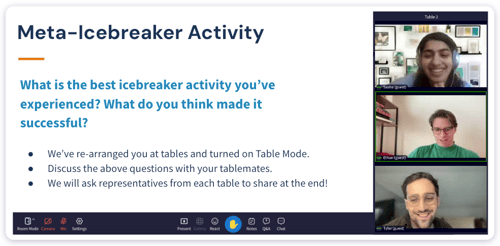
4. Virtual Background Challenge
How It Works: Encourage learners to set a virtual background related to a fun theme, such as their favorite vacation spot or dream travel destination. These can include images of real places, photos from past trips taken by your learners, or even fictional worlds from books and movies. As each learner joins, they can briefly share the reason or story behind their background.
Why It's Effective: The visual aspect of this icebreaker makes it memorable and enjoyable, and it can be enjoyed for the whole session if your learners keep their virtual backgrounds! As your learners share the stories behind their backgrounds, it naturally sparks conversations about shared interests and experiences.
READ MORE: 5 Ways to Increase Student Engagement in Online Education
5. Joyful Items
How It Works: Turn off the cameras and microphones of your learners, then give them two minutes to find an item in their space that brings them joy or has a deeper story. Ask them to jot down some notes around the story or why the item brings them joy to collect their thoughts. In pairs, your learners can turn back on their cameras and share their items with a peer. Give them enough time to share and discuss. Once the pairs have shared, you can open up the room for anyone who would like to share their item's story with the whole class.
Why It's Effective: This exercise brings a personal touch to the virtual classroom, allowing learners to connect on a more personal level. It’s a gentle way to open up and share a piece of their world. Keeping the discussion one-on-one at first allows learners to share their stories in a safe, intimate setting.
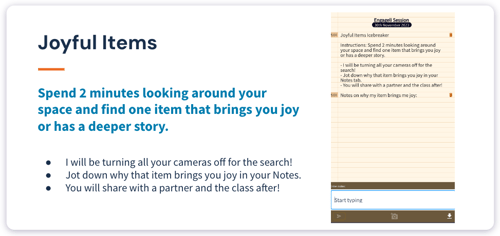
6. Speed Networking
How It Works: Similar to speed dating, this involves pairing learners for brief, timed conversations. They can discuss predefined topics or share something about themselves, like a personal story or hobby. You can rotate pairs as many times as you would like, allowing learners to connect with a wide range of classmates.
Why It's Effective: This method allows learners to meet multiple peers in a short period of time. These quick conversations help build community among learners and discover common interests. Plus, the rapid pace keeps everyone engaged!
7. Share Your Expertise
How It Works: Begin this activity by asking your learners the following question: "What's something you could speak about for 30 minutes, without any preparation?" Encourage them to reflect on their interests, skills, and experiences. Then, invite everyone to write their topic on a sticky note and add it to a class-wide virtual whiteboard.
Why It's Effective: This icebreaker not only gives learners space to reflect on their own areas of expertise and interest but also builds community and common ground among your class. Following the sharing on the whiteboard, you can ask learners to briefly speak about their area of expertise to promote public speaking on a comfortable topic.
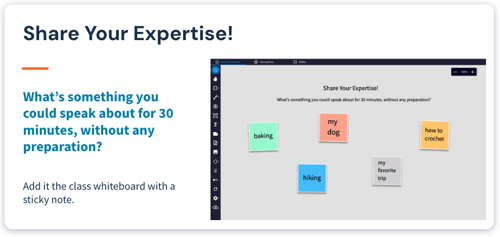
8. Mood Meter Check-In
How It Works: Begin each class by inviting learners to check in with their current mood. You can do this through emojis or text, using live reactions or word clouds. This provides learners with a quick way to express their current mood, plus helps you understand the group's emotional state.
Why It's Effective: This icebreaker is a powerful tool for creating a supporting classroom environment. By regularly incorporating this activity, you can build a culture of openness within your class.
9. Collaborative Brainstorming Session
How It Works: This icebreaker is great for helping learners construct ideas and detail their thinking to develop solutions. Give learners 5 minutes to think on their own about a particular topic. During this independent thinking time, encourage them to take notes to organize their thoughts. Then, bring the whole class together around a virtual whiteboard, flowchart, mind map, or scrum board. Ask everyone to add their ideas via sticky notes. You can then use these class-generated ideas to launch a discussion and determine next steps.
Why It's Effective: This activity fosters collaborative thinking and creativity. It’s particularly effective for more in-depth discussions and brainstorming sessions, particularly when you want to highlight student-led solutions.
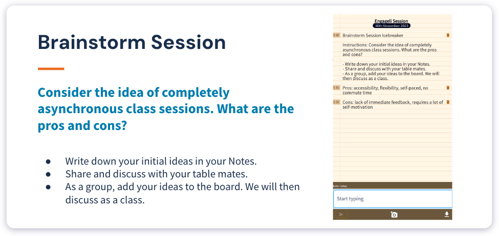
10. Virtual Scavenger Hunt
How It Works: Organize a virtual scavenger hunt by creating a list of items, ranging from common household items to more quirky objects that learners can find in their homes. Share this list with your learners and set a countdown timer with just enough time to add a sense of urgency. Then, send your learners out into their homes to find the items. Once the countdown is over, they can share their finds on camera with the class.
Why It's Effective: This activity is lively and interactive, getting learners moving and adding an element of friendly competition. It's a great way to energize the class and bring in some fun. Plus, you'll get to know more about your learners based on the items they share.
Incorporating these icebreakers in your virtual classrooms will not only warm up your sessions but will be the first step in creating an active learning environment. Active teaching, unlike traditional methods of passive learning, allows you to foster a community of active learners who are comfortable, engaged, and ready to collaborate. The key to a successful icebreaking session is to be inclusive, encouraging, and most importantly, to have fun.
Happy teaching!
Want to learn more about creating engaging and impactful virtual sessions? Check out the results from the Active Learning Impact Study. This research study found that active learning virtual sessions can create a 13x increase in talk time, 16x more nonverbal engagement, and test scores 54% higher when compared to passive learners in a traditional lecture setting.
![]() Interested in experiencing Engageli's new features firsthand?
Interested in experiencing Engageli's new features firsthand?
Try our new immersive experience to explore the Engageli platform!


